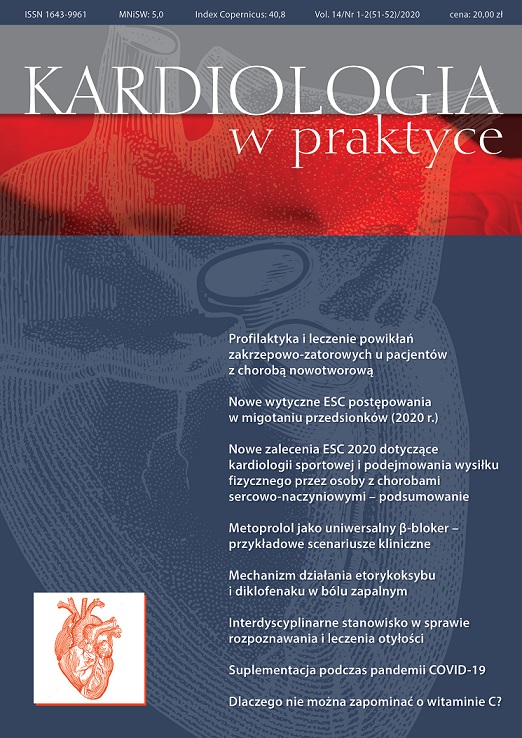Mechanizm działania etorykoksybu i diklofenaku w bólu zapalnym Artykuł przeglądowy
##plugins.themes.bootstrap3.article.main##
Abstrakt
NLPZ są jednymi z najczęściej stosowanych leków w farmakoterapii bólu. Mechanizm działania NLPZ związany jest przede wszystkim z zahamowaniem syntezy prostaglandyn, pośredniczących w rozwoju stanu zapalnego, co ma priorytetowe znaczenie w leczeniu bólu o podłożu zapalnym. Diklofenak to lek pierwszego wyboru w ChZS oraz w spondyloartropatiach. Etorykoksyb, stosunkowo nowy na rynku polskim NLPZ, jest lekiem z wyboru w leczeniu objawowym ChZS, ZZSK, RZS, napadu dny moczanowej, ostrego bólu po wymianie stawu biodrowego [1–5].
Pobrania
##plugins.themes.bootstrap3.article.details##

Utwór dostępny jest na licencji Creative Commons Uznanie autorstwa – Użycie niekomercyjne 4.0 Międzynarodowe.
Copyright: © Medical Education sp. z o.o. This is an Open Access article distributed under the terms of the Attribution-NonCommercial 4.0 International (CC BY-NC 4.0). License (https://creativecommons.org/licenses/by-nc/4.0/), allowing third parties to copy and redistribute the material in any medium or format and to remix, transform, and build upon the material, provided the original work is properly cited and states its license.
Address reprint requests to: Medical Education, Marcin Kuźma (marcin.kuzma@mededu.pl)
Bibliografia
2. van der Heijde D, Ramiro S, Landewé R et al. 2016 update of the ASAS-EULAR management recommendations for axial spondyloarthritis. Ann Rheum Dis. 2017; 76: 978-91.
3. Combe B, Landewe R, Daien CI et al. 2016 update of the EULAR recommendations for the management of early arthritis. Ann Rheum Dis. 2017; 76: 948-59.
4. McAlindon E, Bannuru RR, Sullivan MC et al. OARSI guidelines for the non-surgical management of knee osteoarthritis. Osteoarthritis Cartilage. 2014; 22: 363-88.
5. Online: http://www.ema.europa.eu.
6. Chan CC, Boyce S, Brideau C et al. Pharmacology of a selective cyclooxygenase-2 inhibitor, L-745,337: A novel nonsteroidal anti-inflammatory agent with an ulcerogenic sparing effect in rat and nonhuman primate stomach. J Pharmacol Exp Ther. 1995; 274: 1531-7.
7. Riendeau D, Percival MD, Brideau C et al. Etoricoxib (MK-0663): Preclinical Profile and Comparison with Other Agents That Selectively Inhibit Cyclooxygenase-2. J Pharmacol Exp Ther. 2001; 296: 558-66.
8. Renner B, Zacher J, Buvanendran A et al. Absorption and distribution of etoricoxib in plasma, CSF, and wound tissue in patients following hip surgery – a pilot study. Naunyn-Schmied Arch Pharmacol. 2010; 381: 127-36.
9. Arendt-Nielsen L, Egsgaard LL, Petersen KK. Evidence for a central mode of action for etoricoxib (COX-2 inhibitor) in patients with painful knee osteoarthritis. Pain. 2016; 157: 1634-44.
10. Ghanghas P, Jain S, Rana C et al. Chemoprevention of Colon Cancer through Inhibition of Angiogenesis and Induction of Apoptosis by Nonsteroidal Anti-Inflammatory Drugs. J Environ Pathol Toxicol Oncol. 2016; 35: 273-89.
11. Nadda N, Vaish V, Setia S et al. Angiostatic role of the selective cyclooxygenase-2 inhibitor etoricoxib (MK0663) in experimental lung cancer. Biomed Pharmacother. 2012; 66: 474-83.
12. Citraro R, Leo A, Marra R et al. Antiepileptogenic effects of the selective COX-2 inhibitor etoricoxib, on the development of spontaneous absence seizures in WAG/Rij rats. Brain Res Bull. 2015; 113: 1-7.
13. Burmester G, Lanas A, Biasucci L et al. The appropriate use of non-steroidal anti-inflammatory drugs in rheumatic disease: opinions of a multidisciplinary European expert panel. Ann Rheum Dis. 2011; 70: 818-22.
14. Coxib and traditional NSAID Trialists' (CNT) Collaboration. Vascular and upper gastrointestinal effects of non-steroidal anti-inflammatory drugs: meta-analyses of individual participant data from randomised trials. Lancet. 2013; 382: 769-79.
15. Cannon CP, Curtis SP, FitzGerald GA et al. Cardiovascular outcomes with etoricoxib and diclofenac in patients with osteoarthritis and rheumatoid arthritis in the Multinational Etoricoxib and Diclofenac Arthritis Long-term (MEDAL) programme: a randomised comparison. Lancet. 2006; 368: 1771-81.
16. van Walsem A, Pandhi S, Nixon RM et al. Relative benefit-risk comparing diclofenac to other traditional non-steroidal anti-inflammatory drugs and cyclooxygenase-2 inhibitors in patients with osteoarthritis or rheumatoid arthritis: a network meta-analysis. Arthritis Res Ther. 2015; 17: 66.
17. Tielemans MM, Eikendal T, Jansen JB et al. Identification of NSAID users at risk for gastrointestinal complications: a systematic review of current guidelines and consensus agreements. Drug Saf. 2010; 33: 443-53.
18. Moore RA, Moore OA, Derry S et al. Responder analysis for pain relief and numbers needed to treat in a metaanalysis of etoricoxib osteoarthritis trials: bridging a gap between clinical trials and clinical practice. Ann Rheum Dis. 2010; 69: 374-79.
